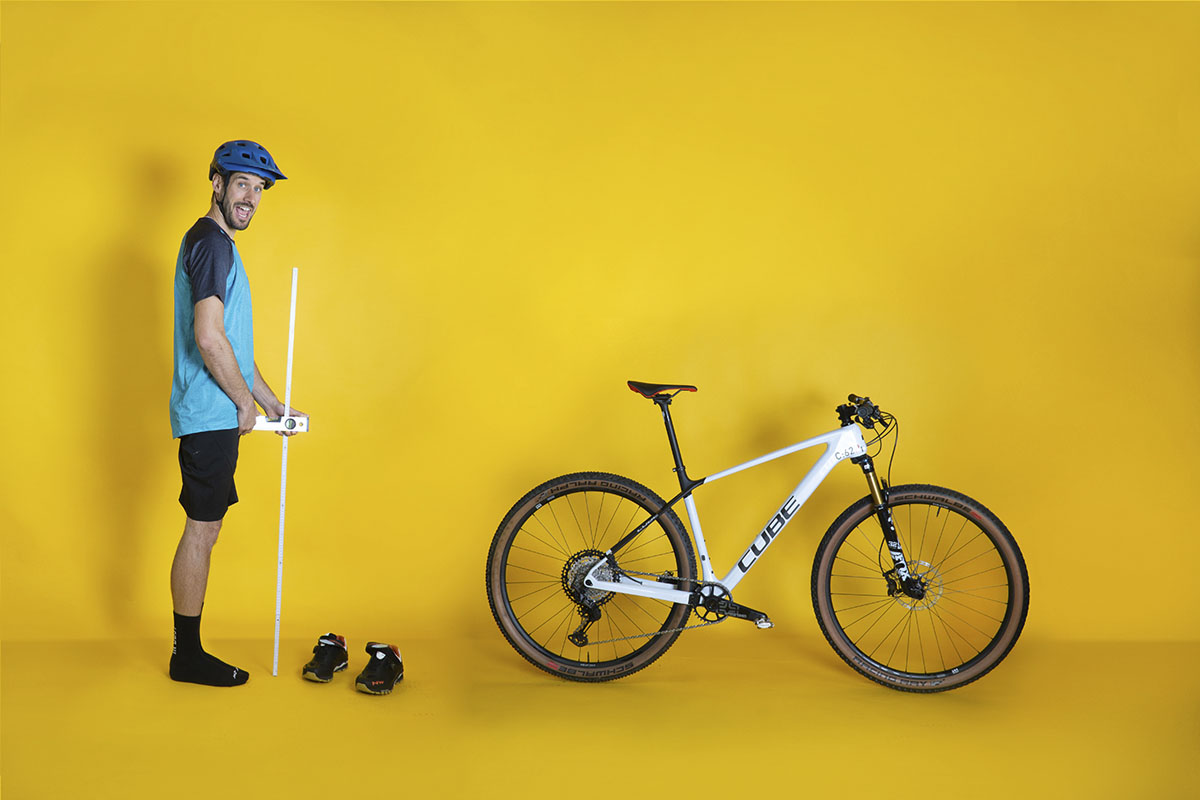Selecting the appropriate bicycle size is crucial for ensuring comfort, performance, and safety. Riding a bicycle that is too small or too large can lead to discomfort, inefficiency, and even injuries. Consequently, understanding how to choose the right bike size based on your measurements and intended use can enhance your cycling experience. Therefore, this comprehensive guide provides a step-by-step approach to determining the correct bicycle size, covers common issues, offers fitting tips, and discusses when to seek professional advice. By exploring these aspects, you can confidently select the right bike size and enjoy a comfortable and efficient ride.
Understanding Bike Sizing Basics
Before diving into the measurement process, it’s essential to understand the basics of bike sizing. Knowing these fundamentals helps you make informed decisions. Therefore, exploring bike sizing basics is crucial.

Types of Bike Frames
Bicycles come in various frame types, each designed for different riding styles and terrains. Common types include road bikes, mountain bikes, hybrid bikes, and BMX bikes. Each frame type has its own sizing conventions and design features. Road bikes typically have a more aggressive geometry for speed, while mountain bikes have a sturdier, more upright design for rough terrains. Hybrid bikes combine features of road and mountain bikes, offering versatility for varied terrains. Understanding the frame type suited for your needs helps narrow down the sizing options. By recognizing the importance of frame types, you can better tailor your bike choice to your riding style. Therefore, understanding bike frame types is crucial.
Importance of Correct Bike Size
The correct bike size ensures optimal comfort, performance, and safety. A properly sized bike allows you to maintain proper posture, reducing the risk of strains and discomfort. It also enhances pedaling efficiency, allowing you to maximize power and endurance. The right size ensures better control and stability, enhancing safety during rides. By understanding the importance of a correctly sized bike, you appreciate the benefits it offers to your overall cycling experience. Therefore, recognizing the significance of bike sizing is essential.
Measurements and Sizing Charts
Accurate measurements and understanding sizing charts are key steps in determining the right bike size. Following these steps ensures a precise fit. Therefore, exploring measurements and sizing charts is essential.
Taking Measurements
To determine the right bike size, you need to take specific body measurements. Key measurements include your inseam length, height, and reach.
- Inseam Measurement: Stand with your feet shoulder-width apart and measure the distance from the ground to your crotch. This measurement helps determine the appropriate frame size and standover height.
- Height Measurement: Stand against a wall and measure your total height from the floor to the top of your head. This measurement provides a general guideline for bike size.
- Reach Measurement: Measure the distance from your shoulder to the tips of your fingers to determine the reach length. This helps in assessing the top tube length and handlebar reach.
By accurately taking these measurements, you gather the necessary data to compare against bike sizing charts. Therefore, recognizing the importance of accurate measurements is crucial.
Interpreting Sizing Charts
Bike sizing charts vary depending on the manufacturer and bike type. These charts typically list recommended frame sizes based on height and inseam measurements. Cross-referencing your measurements with these charts helps identify the appropriate frame size. For example, if your inseam length is 30 inches and your height is 5’7″, the chart may recommend a medium frame size for a road bike. Pay attention to any specific sizing recommendations provided by the manufacturer for different bike models. By interpreting sizing charts correctly, you ensure a better fit for your bike. Therefore, understanding how to use sizing charts is essential.

Adjusting for Riding Style and Purpose
Adjusting the bike size based on your riding style and intended use ensures optimal performance and comfort. Considering these factors helps tailor your bike choice. Therefore, exploring adjustments for riding style and purpose is crucial.
Road Biking
For road biking, a more precise fit is essential to maximize efficiency and comfort during long rides. Road bikes typically have a more aggressive posture, with riders leaning forward to reduce air resistance. Ensure that the top tube length suits your reach to avoid overstretching or crowding. A longer leg makes full leg extension possible, optimizing pedaling efficiency. Test ride different frame sizes to find the one that provides the ideal balance of comfort and performance. By adjusting for road biking specifics, you ensure a better riding experience. Therefore, recognizing the importance of tailored adjustments is crucial.
Mountain Biking
Mountain biking requires a different approach to bike sizing due to the varied terrains and riding conditions. A slightly smaller frame size provides more maneuverability and control, which is crucial for navigating trails and obstacles. Ensure that the standover height allows you to easily dismount in case of sudden stops or challenging terrain. The handlebar height and reach should allow for a more upright posture, providing better control and reducing strain. Test the bike on different terrains to ensure it handles well and provides the necessary comfort. By adjusting for mountain biking specifics, you enhance safety and performance. Therefore, understanding these adjustments is essential.

Fitting Tips and Adjustments
Proper bike fitting involves more than just frame size. Making finer adjustments ensures optimal comfort and performance. Following these fitting tips guarantees a better fit. Therefore, exploring fitting tips and adjustments is essential.
Saddle Height
Adjusting the saddle height ensures proper leg extension and pedaling efficiency. To find the correct saddle height, place your heel on the pedal at its lowest point. Your leg should be fully extended with a slight bend in the knee. This helps prevent knee strain and maximizes power output. Adjust the saddle height accordingly and ensure it’s securely fastened. By setting the correct saddle height, you enhance comfort and efficiency. Therefore, recognizing the importance of saddle height adjustment is crucial.
Handlebar Position
The handlebar position significantly affects your comfort and control. Adjust the handlebar height and reach to suit your riding posture. For road bikes, a lower handlebar position reduces air resistance, while a higher position offers more comfort. Mountain and hybrid bikes typically benefit from a more upright handlebar position for better control and reduced strain. Adjust the angle and distance of the handlebars to ensure a comfortable grip and easy access to controls. By fine-tuning the handlebar position, you improve overall comfort and handling. Therefore, understanding the importance of handlebar adjustments is essential.
Troubleshooting Common Issues
Despite careful sizing and fitting, some issues may still arise. Understanding common problems and their solutions ensures a better riding experience. Therefore, exploring troubleshooting tips is crucial.
Discomfort and Pain
Discomfort and pain can result from improper bike sizing or incorrect adjustments. If you experience knee pain, re-evaluate your saddle height and position to ensure proper leg alignment. Lower back or neck pain may indicate a need to adjust the handlebar position for a more comfortable reach. Hand numbness can result from too much pressure on the handlebars, requiring adjustments to the grip or handlebar angle. Regularly assess your posture and make incremental changes until discomfort is minimized. By addressing discomfort and pain, you enhance your cycling experience. Therefore, recognizing solutions to these issues is important.
Inefficient Performance
Inefficient performance, such as difficulty maintaining speed or quick fatigue, may indicate incorrect bike sizing or adjustments. Reassess your measurements and frame size to ensure they match your body proportions and riding style. Check the saddle height, handlebar position, and overall bike fit for any inconsistencies. Address any misalignments or incorrect settings promptly. Proper bike size and adjustments ensure better power transfer and endurance. By troubleshooting performance issues, you optimize your bike’s efficiency. Therefore, understanding the importance of resolving these problems is essential.

Maintenance and Regular Checks
Regular maintenance and checks ensure your bike remains in optimal condition and fit. Understanding these practices helps prevent issues and extend the bike’s lifespan. Therefore, exploring maintenance and regular checks is essential.
Regular Tune-Ups
Regular tune-ups keep your bike in top shape and address any fitting issues that may arise over time. Schedule tune-ups every six months or as needed, depending on usage. During a tune-up, inspect the frame, components, and adjustments made previously. Adjust the saddle and handlebars as needed based on wear or changes in riding style. Lubricate moving parts and check for any signs of wear or damage. By performing regular tune-ups, you maintain the bike’s performance and fit. Therefore, recognizing the importance of tune-ups is crucial.
Periodic Fit Assessments
As you ride and your cycling abilities progress, periodic fit assessments help ensure your bike remains comfortable and efficient. Reevaluate your measurements and make any necessary adjustments to the saddle height, handlebar position, and overall fit. Consider professional bike fitting services for more precise adjustments tailored to your evolving needs. Regularly assess your posture and comfort during rides to identify any emerging issues. By performing periodic fit assessments, you ensure a consistently comfortable and efficient ride. Therefore, understanding the importance of regular assessments is essential.
When to Seek Professional Help
While determining the right bike size is manageable with proper guidance, some situations require professional assistance. Knowing when to seek help ensures the best fit and performance. Therefore, exploring scenarios warranting professional help is crucial.
Specialized Bike Fitting Services
For precise and personalized fitting, consider seeking specialized bike fitting services. Professionals use advanced tools and techniques to assess your body measurements, posture, and riding style. They provide detailed recommendations for frame size, saddle height, handlebar position, and more. Specialized fitting services are especially beneficial for competitive cyclists or those experiencing persistent discomfort. By seeking professional fitting, you ensure the best possible fit and performance. Therefore, understanding the value of expert fitting services is crucial.
Complex Fit Issues
If you encounter complex fit issues, such as discomfort despite multiple adjustments or difficulty finding the right bike size, professional help may be needed. Professionals can identify underlying problems and provide tailored solutions that address your specific requirements. They can also recommend specialized components or modifications to enhance comfort and performance. By seeking help for complex fit issues, you ensure a better riding experience. Therefore, recognizing when to seek professional assistance is essential.
Common Misconceptions About Bike Sizing
Addressing common misconceptions about bike sizing provides clarity and fosters a better understanding of the process. Dispelling these myths ensures accurate knowledge. Therefore, exploring common misconceptions is important.
Misconception: One Size Fits All
A common misconception is that a single bike size can fit all riders. In reality, bike sizing is highly individual and varies based on body measurements, riding style, and bike type. Different manufacturers may have varying sizing standards, further emphasizing the need for personalized fitting. By understanding the individual nature of bike sizing, you appreciate the need for accurate measurements and tailored adjustments. Therefore, dispelling this myth highlights the importance of a personalized approach.

Misconception: Height Alone Determines Bike Size
Another misconception is that height alone determines the appropriate bike size. While height provides a general guideline, other measurements such as inseam length, reach, and overall body proportions are crucial for determining the best fit. Ignoring these factors can lead to discomfort and inefficiency. By recognizing the importance of multiple measurements, you ensure a more accurate and comfortable fit. Therefore, understanding the need for comprehensive measurements is essential.
Conclusion: Finding Your Perfect Bike Size
Determining the right bicycle size is essential for a comfortable, efficient, and enjoyable ride. Proper preparation, including understanding bike sizing basics and taking accurate measurements, ensures a smooth and effective process.
Interpreting sizing charts and adjusting for riding style and purpose tailors your bike choice to your specific needs. Making finer adjustments to the saddle height and handlebar position guarantees optimal comfort and performance.
Troubleshooting common issues promptly addresses potential problems, enhancing your cycling experience. Regular maintenance and periodic fit assessments ensure your bike remains in optimal condition and fit over time.
Recognizing when to seek professional help for specialized fitting services or complex fit issues ensures the best possible outcome. Addressing common misconceptions about bike sizing provides clarity and encourages a personalized approach to finding the perfect fit.
By embracing these aspects, you can confidently choose the right bike size and enjoy a comfortable and efficient ride. Therefore, whether you are a seasoned cyclist or a newcomer, mastering the art of bike sizing enhances your riding experience and overall satisfaction. Enjoy the improved comfort, performance, and enjoyment that come with a properly sized bike, knowing you have taken the necessary steps to ensure a perfect fit!


